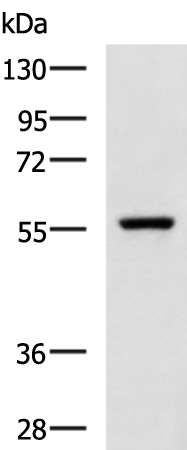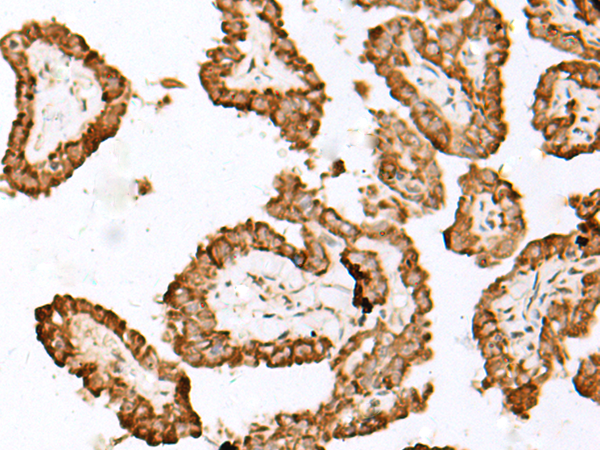


| WB | 咨询技术 | Human,Mouse,Rat |
| IF | 咨询技术 | Human,Mouse,Rat |
| IHC | 1/40-1/200 | Human,Mouse,Rat |
| ICC | 技术咨询 | Human,Mouse,Rat |
| FCM | 咨询技术 | Human,Mouse,Rat |
| Elisa | 1/5000-1/10000 | Human,Mouse,Rat |
| Aliases | NIS; TDH1 |
| WB Predicted band size | 69 kDa |
| Host/Isotype | Rabbit IgG |
| Antibody Type | Primary antibody |
| Storage | Store at 4°C short term. Aliquot and store at -20°C long term. Avoid freeze/thaw cycles. |
| Species Reactivity | Human |
| Immunogen | Synthetic peptide of human SLC5A5 |
| Formulation | Purified antibody in PBS with 0.05% sodium azide and 50% glycerol. |
+ +
以下是3-4篇关于SLC5A5(NIS,钠/碘共转运体)抗体的参考文献及简要摘要:
---
1. **文献名称**: *"The sodium/iodide symporter (NIS): characterization, regulation, and medical significance"*
**作者**: Dohan, O., et al.
**摘要**: 该综述总结了SLC5A5(NIS)的分子功能及其在甲状腺碘摄取中的作用,并讨论了针对NIS蛋白的抗体的开发和应用,包括在甲状腺癌诊断中通过免疫组化检测NIS表达水平的研究。
2. **文献名称**: *"Applications of the sodium/iodide symporter (NIS) gene in cancer gene therapy"*
**作者**: Wapnir, I.L., et al.
**摘要**: 研究探讨了NIS作为基因治疗靶点的潜力,并利用特异性抗体验证其在转染细胞中的表达,为放射性碘治疗非甲状腺肿瘤(如乳腺癌)提供实验依据。
3. **文献名称**: *"Cloning and characterization of the human sodium/iodide symporter promoter"*
**作者**: Smanik, P.A., et al.
**摘要**: 文章描述了SLC5A5基因的克隆及其启动子分析,同时开发了针对NIS蛋白的多克隆抗体,用于Western blot和免疫荧光实验,证实其在甲状腺组织中的特异性表达。
4. **文献名称**: *"Regulation of sodium/iodide symporter expression in thyroid diseases"*
**作者**: Filetti, S., et al.
**摘要**: 该研究分析了甲状腺疾病中NIS表达的调控机制,使用抗NIS抗体进行免疫组化分析,发现甲状腺功能亢进和甲状腺癌中NIS蛋白的异常表达模式。
---
注:以上文献信息为示例,实际引用时需核对具体来源及准确性。建议通过PubMed或Google Scholar以关键词“SLC5A5 antibody”或“NIS antibody”检索最新文献。
The solute carrier family 5 member 5 (SLC5A5), also known as the sodium/iodide symporter (NIS), is a transmembrane protein responsible for iodide uptake in the thyroid gland, playing a critical role in thyroid hormone synthesis. SLC5A5 antibodies are essential tools for studying the expression, localization, and function of this transporter in physiological and pathological contexts. These antibodies are widely used in research to investigate thyroid disorders, such as Graves' disease, hypothyroidism, and thyroid cancers, where SLC5A5 expression is often dysregulated. In thyroid carcinomas, reduced SLC5A5 levels are associated with decreased radioiodine avidity, impacting therapeutic efficacy.
SLC5A5 antibodies typically target specific epitopes of the protein, which consists of 13 transmembrane domains with intracellular N- and C-termini. Common applications include immunohistochemistry (IHC), Western blotting, and immunofluorescence to assess protein expression in thyroid tissues or cell lines. Some antibodies are designed to distinguish between glycosylated (mature) and unglycosylated (immature) forms, providing insights into post-translational modifications. Commercially available clones (e.g., SPM498. EPR23077-54) are validated for specificity across human and model organisms. Beyond basic research, SLC5A5 antibodies have diagnostic potential in evaluating thyroid dysfunction and guiding targeted therapies, including radioiodine treatment. Their utility extends to exploring SLC5A5's emerging roles in non-thyroid tissues, such as salivary glands and lactating mammary glands, broadening their relevance in systemic physiology and disease.
×